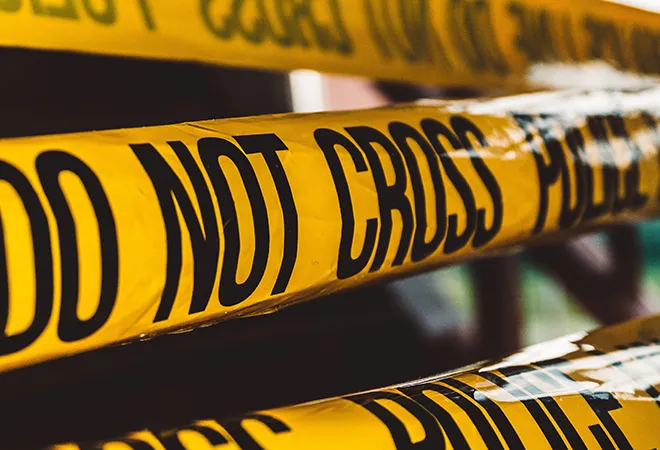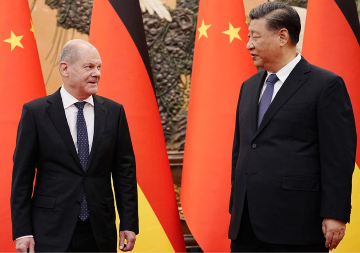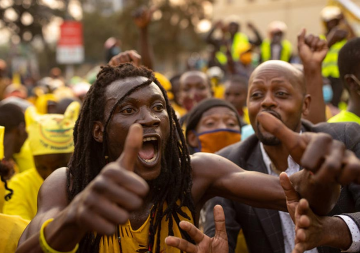
Walking down the Colaba Causeway, past the renovated face of Cafe Leopold, in the shadow of the iconic Taj Mahal, or in Kalaghoda, abutting the Jewish Chabad house where scars of violence have been swallowed up by the cracks in its decaying walls, it takes a minute to remember the bloodshed and mayhem let loose on these Mumbai landmarks on the 26th of November 2008. In the decade gone by, time has stood as still as it has moved on. While the Indian government still waits for Pakistan to bring the masterminds of 26/11 to justice, grieving families of victims have tried to rebuild their lives in different cities around the world; and social media — a nascent ally of the traditional press in 2008, has become more powerful than anyone could have imagined, in disseminating information and shaping opinions across the world.
It is a little talked about fact, but The Daily Telegraph’s journalist Claudine Beaumont wrote, just a day after the siege of Mumbai began, that Twitter and Flickr users not only broke the news first <1>, but continued to provide instant, eyewitness accounts <2> of the unfolding horror in a steady, invaluable stream of information. Onlookers uploaded photos to blogs, hostages inside the hotels tweeted about terrorists demanding to know nationalities of guests from the hotel reception <3>. In addition, many hostages were calling their families and sending emails or text messages as and when they could. On Twitter, #Mumbai was trending, and this new trend of hashtags made it easier for families and journalists to receive blow by blow accounts of what was happening on the streets, in the train station, inside the buildings and hotels under attack <4>. Twenty-four-hour news television cameras were trained on each location. This was a major news story, after all. And, intercepts of phone calls between terrorists and their handlers indicated they were watching the news too- informing attackers of details they gleaned from the reports and reminding them to persist, for the ‘glory’ of martyrdom awaited them — all in real time.
While the Indian government still waits for Pakistan to bring the masterminds of 26/11 to justice, grieving families of victims have tried to rebuild their lives in different cities around the world; and social media — a nascent ally of the traditional press in 2008, has become more powerful than anyone could have imagined, in disseminating information and shaping opinions across the world.
In times of crisis, all over the world — journalists face a demanding audience while navigating difficult reporting environments. Terror strikes, or unfolding hostage crises make their role even more complex. Everyone looks to news media for information and updates and journalists struggle to find balance between preserving National (State) interest and Public (Citizen’s) interests. This is naturally easier for State owned media that follow only one stream of information. But for the rest, the line is often a fine one, and an absence of crisis protocols for news coverage make things even more difficult.
Off the record, top Indian government sources admit that by and large, when governments and law enforcement authorities put systems in place in a crisis, the media — even privately-owned networks and newspapers — does comply. Internationally, such examples abound — the coverage of the aftermath of 9/11 or the 7/7 London bombings are cases in point. The media followed guidelines put in place for both access and display of visuals that could have inflamed passions. They broadcast information released in regular briefings by police, intelligence and administrative officials. In crisis situations, a few things happen immediately. A perimeter is set up by first responders — usually local law enforcement, a crisis group convenes to stay in touch with families, and control rooms are set up where officials deployed to ensure authoritative, credible and clear information give systematic, periodic briefings to the media — a critical player in any national emergency.
None of this happened during the siege of Mumbai. Instead, reporters and camerapersons tried to get as close to the sites as possible, some even stood alongside National Security Guards Chief J.K. Dutt, as he directed operations. As a result, some reporters, themselves in an unprecedented environment ended up reporting operational details, like those of fires being lit inside the hotels under attack, in an attempt to literally smoke out the terrorists. Without appropriate systems and channels of information in place, journalists went by what they saw, what was visible to the naked eye, and to the ordinary citizen, some of them, breathlessly. It was through news television that terrorists realised fires had been lit and that helicopters were trying to land on the roofs of the Oberoi Hotel and the Jewish Chabad House with an American Rabbi and his family being held inside. Was it poor judgement of the journalists to release this information? With the benefit of hindsight, the answer possibly, is yes. But, for a government under attack for a security failure of epic proportions, deflecting blame was key. News media became the ‘fall guy’. Citing phone intercepts between terrorists and their handlers, the political spokespersons placed the lion’s share of blame for the mayhem terrorists were able to spread during the 60-hour long siege squarely on the mainstream media, particularly live, commercialised, 24-hour news television. But the truth is, if 26/11 was India’s 9/11, India’s immediate response was far from optimal.
For any government, live hostage situations are never easy. In the case of the hijacking of IC 814 in December 1999 over a decade before 26/11, and well before the advent of social media, the Indian government held mainstream media responsible for the pressure it faced by families of hostages to act swiftly. Without the government’s own standard operating procedures to sequester families in place and set up an organised information channel that both families and journalists could have access to, hostages’ relatives held a sit in outside the Prime Minister’s residence. The pictures were splashed across the few TV networks and all the newspapers. To be charitable to a government that sent its foreign minister as a personal escort to terrorists being freed in exchange for the hostages who were held on the tarmac in Kandahar for over a week, one can argue that the crisis was unprecedented. But even then, blaming the media was a diversion from the sharp attack that agencies came under for their inability to prevent the hijacking in the first place, and then for their subsequent ineptitude in failing to act while the aircraft was still within Indian territory. 26/11 told us, even a decade later, the situation was still as chaotic.
We know today that a crisis management group comprising of high level intelligence officers, defence personnel and bureaucrats met late at night on the 26 November 2008 after officials received calls — either to ‘turn on the TV’ and see what was unfolding, or from journalists calling to ask for information. Convening a meeting was, in fact, standard procedure when a crisis unfolded. But officials present that night say it was chaotic and no one was able to take quick, critical decisions. A day after the attacks, as special commandos of the National Security Guard landed in Mumbai, top media owners were summoned to South Block. The government was clear. Wall to wall coverage was against ‘national interest’ as the phone intercepts suggested. Senior government officials from the Defence and Home ministries and across intelligence and security agencies reprimanded television news networks. In the immediate aftermath of the attacks, the Ministry of Information and Broadcasting issued notices to two Hindi news channels — Aaj Tak and India TV. However, official sources admit they had no answer when asked if the networks in question had indeed violated any Standard Operating Procedure (SOP) for the media in crisis situations. Why were there no guidelines created — in consultation, by taking media owners into confidence on how best to devise a communications strategy in such situations? While reviewing the failures and addressing new challenges, the absence of a simple protocol was glaring. In fact, it took an attack like 26/11 for both the government and the media industry to evolve new frameworks for coverage.
A day after the attacks, as special commandos of the National Security Guard landed in Mumbai, top media owners were summoned to South Block. The government was clear.
It is not unusual for governments in crisis or warlike situations (and some bureaucrats argue 26/11 was an act of war), to black out access and filter information. In fact, Indian journalists have seen this with the Kargil war, when daily periodic briefings jointly held by the Army, Air Force and Ministry of External Affairs provided the media with credible information. It is also no secret that terrorist groups, like anyone else — use communications media for propaganda. History tells us that the media is as important a tool for the citizens and the state as it is for those who wreak havoc on them. And journalists who have sometimes found themselves or their platforms manipulated, have, on their own, changed rules of conduct to safeguard against this manipulation, over the years. Similarly, after the Mumbai attacks of 26 November 2008, under a committee headed by Justice JS Verma, India’s News Broadcasters Association, an autonomous industry body for TV news channels came up with a new set of guidelines <6> for the coverage of emergency situations (armed conflict, internal disturbance, communal violence, public disorder and crime). Even today, the code is governed by the National Broadcasting Standards Association that can issue notice suo-moto, or on the basis of viewer complaints.
NBA GUIDELINES FOR CRISIS AND CONFLICT
-
Coverage is to be tested on the ‘touchstone of public interest,’ and must be factually accurate and objective.
-
There should be no live reporting that “facilitates publicity of any terrorist or militant outfit, its ideology or tends to evoke sympathy towards or glamorise their cause.”
-
During live hostage situations and rescues, no details of pending rescue operations should be given or broadcast regarding methods or personnel.
-
Respect should be shown to the dead and no gory visuals should be shown on TV.
-
Reporters should refrain from being in live, direct contact with victims, security forces, technical personnel or perpetrators.
-
Networks should refrain from continuous/unnecessary broadcast of archival footage that may agitate the viewers. (If any such footage is shown, it should clearly indicate ‘file,’ with date and time.)
|
Self-regulation by an autonomous body — though not always foolproof, has a strong influence on most newsrooms. The threat of ex-communication by one’s own fraternity is often a far greater control than any government attempts to censure journalists The National Broadcasters Association also tries to ensure that the line between national interest and political interests stays clear. In 2015, the BJP led government sent notices to three channels for their coverage of the hanging of Yakub Memon <7> — the brother of one of the masterminds of the serial Mumbai blasts of 1993. In another case, the government cited national security and tried to ban NDTV India <8> for a day over its coverage of the attacks on the Indian Air Force base in Pathankot in January 2016 where the government alleges that ‘sensitive information’ about the vicinity of the air base was reported. In both cases, given a history of adversarial relations between the networks in question and the party running government, the Ministry of Information and Broadcasting show cause notices didn’t hold up to NBA scrutiny. <9> While media houses responded to all notices, the ban on NDTV India for Pathankot coverage has been held in abeyance with the possibility it can be invoked at any time.
For the most part however, evidence now indicates that private broadcast news media in India have complied with crisis reportage guidelines since they were put in place. Whether or not the government evolved better security strategies and developed Standard Operating Procedures for communications in crisis, the media has learned from past mistakes and experience. When they were announced, senior ministers welcomed the NBA’s guidelines as a ‘step in the right direction,’ and accepted that both the government and the media had lessons to learn from the handling of the Mumbai attacks. In the decade gone by since 26/11, reportage of riots and terror strikes, including those on the Indian Air Base in Pathankot and an army camp in Uri in Jammu and Kashmir, has broadly indicated this commitment. The case is similar for coverage of riots around the Delhi gang rape in 2012, or communal riots in Uttar Pradesh and West Bengal where newsrooms have tried to exercise control over releasing potentially sensitive information.
Broadly, with a few minor exceptions, networks do display restraint in terms of live visuals and news updates from reporters on the field. The bigger challenge today however, is news studio debates with ideological anchors and the rapid spread of social media to create echo chambers of hate based on religion or political persuasion. While social media can, and has been a significant force multiplier to mobilise people and/or public opinion in the shaping of national debates, globally law enforcement and intelligence agencies are dealing with its grave potential for incitement and radicalisation. With different national laws governing different platforms, and very little self-regulation possible, Indian agencies are at a loss when it comes to tackling this new challenge. For the moment, their immediate response is to shut off mobile internet facilities when violence erupts. As in the past, this response too is far from optimal. And the way forward indicates the same lessons of the past — the need for conversations and communication among all stakeholders — governments, mainstream media and now social media organisations — to evolve layered responses in a complex media environment. After all, in a democracy, the role of the media in shaping public opinion cannot be under-stated, or under-estimated.
<1> Claudine Beaumont, Mumbai attacks: Twitter and Flickr used to break news, The Telegraph, 26 November 2008. (accessed on 16 October 2018)
<2> Brian Stelter and Noam Cohen, Citizen Journalists Provided Glimpses of Mumbai Attacks, The New York Times, 29 November 2008. (accessed on 14 October 2018)
<3> @dupree_, 26 November 2008.
<4> @shrinagesh #Mumbai, 26 November 2008.
<5> Murthy, Dhiraj, “Twitter: Microphone for the Masses?” Media, Culture & Society 33, no. 5 (July 2011) pp 779–89 (accessed on 13 October 2018).
<6> NBA to form emergency protocol for coverage of crisis situations, Exchange4media, 11 December 2008. (accessed on 14 October 2018)
<7> P. Vaidyanathan Iyer, Explain why you shouldn’t face action for Yakub’s execution coverage: Govt notice to 3 channels, Indian Express, 8 August 2015. (accessed on 15 October 2018)
<8> Take NDTV India off air on November 9 for Pathankot: I&B panel, Indian Express, 4 November 2018. (accessed on 11 October 2018)
<9> Harveen Ahluwalia, NDTV India ban draws condemnation from editors, journalists, Livemint, 4 November 2018. (accessed on 13 October 2018)
The views expressed above belong to the author(s). ORF research and analyses now available on Telegram! Click here to access our curated content — blogs, longforms and interviews.




 PREV
PREV


